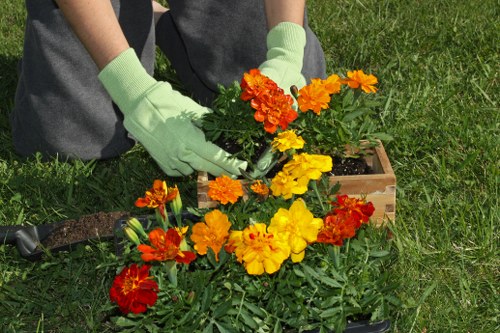Lawn Mowing in Sydenham: Keeping Your Green Space Pristine

Introduction to Lawn Mowing in Sydenham
Maintaining a lush and healthy lawn is a goal for many homeowners in Sydenham. **Lawn mowing** plays a critical role in achieving this, as regular cutting promotes growth, enhances appearance, and prevents the spread of weeds. Whether you have a sprawling garden or a compact yard, understanding the best practices for lawn mowing in Sydenham can make a significant difference in the overall health and beauty of your outdoor space.
Sydenham’s climate offers unique conditions that affect lawn care. The combination of mild temperatures and varying precipitation requires homeowners to adopt specific mowing techniques tailored to the local environment. By adhering to these practices, you can ensure that your lawn remains vibrant and resilient throughout the year.
In this comprehensive guide, we will explore the essentials of lawn mowing in Sydenham, including the optimal mowing frequency, equipment selection, and expert tips to keep your grass looking its best.

Choosing the Right Mowing Equipment
Types of Lawn Mowers
Selecting the appropriate lawn mower is fundamental to effective lawn care. In Sydenham, homeowners typically choose between **gas-powered**, **electric**, and **manual push mowers**. Each type has its advantages and is suited to different lawn sizes and personal preferences.
Gas-Powered Mowers: Ideal for large lawns, gas-powered mowers offer robust performance and the ability to handle thick grass. They are generally more powerful but require regular maintenance, including oil changes and fuel management.
Electric Mowers: Suitable for medium-sized yards, electric mowers are quieter, produce fewer emissions, and are easier to maintain. They can be either corded or cordless, providing flexibility based on your mowing needs.


Electric vs. Gas-Powered: Making the Right Choice
When deciding between electric and gas-powered mowers, consider factors such as lawn size, terrain, and environmental impact. Electric mowers are environmentally friendly and cost-effective in the long run, while gas-powered mowers offer more power for larger and more demanding mowing tasks.
For homeowners in Sydenham looking for a balance between performance and sustainability, a high-quality electric mower may be the best choice. However, if your lawn is extensive or has challenging areas, a gas-powered mower might better meet your needs.
Additionally, cordless electric mowers provide the convenience of maneuverability without the hassle of dealing with gas and fumes, making them a popular choice for many.

Optimal Mowing Practices for a Healthy Lawn
When to Mow Your Lawn
Timing is crucial for effective lawn mowing. In Sydenham, the growing season typically spans from early spring to late autumn. During this period, it’s recommended to mow your lawn regularly, usually once a week, to maintain optimal grass health.
However, mowing frequency may vary based on grass growth rates and seasonal changes. In the peak growing months, more frequent mowing may be necessary, while during slower growth periods, reducing the frequency can prevent stress on the grass.
Proper Mowing Height
Maintaining the correct mowing height is essential for promoting strong root development and preventing weed growth. For most grass types in Sydenham, a mowing height of 2.5 to 3.5 inches is ideal. Cutting the grass too short can damage the roots and make the lawn more susceptible to diseases.

Grass Clipping Management
Properly managing grass clippings can benefit your lawn. Leaving the clippings on the lawn acts as a natural fertilizer, returning essential nutrients to the soil. However, it’s important to mow only when the grass is dry to prevent clumping and ensure that clippings are evenly distributed.
- Mulching Mowers: These mowers finely chop the grass clippings and disperse them back onto the lawn.
- Bagging Mowers: Bagging removes the clippings, which can be disposed of or used as compost.
- Side-Discharge Mowers: These distribute clippings to the side of the mower, ideal for dry conditions.
Seasonal Lawn Care Tips
Spring Mowing Essentials
As spring arrives in Sydenham, it signals the start of the growing season. Begin by raking the lawn to remove debris and dead grass. This prepares the lawn for mowing and promotes healthy growth.
Adjust your mower’s height to the higher end of the recommended range to encourage deep root growth. Additionally, consider aerating the soil to improve nutrient uptake and water retention.
Summer Maintenance Strategies
During the hot summer months, lawns can experience stress due to heat and reduced rainfall. Adjust your mowing schedule to prevent cutting more than one-third of the grass height at a time. Ensuring adequate watering, preferably in the early morning, helps maintain grass health.
Using a high-quality fertilizer can also support the lawn’s resilience against heat and pests.
Autumn Preparation
As autumn approaches, begin to gradually lower your mowing height. This helps the grass prepare for the cooler months and promotes a denser turf. Continue regular mowing until the growth rate slows down in preparation for winter.
- Rake fallen leaves to prevent them from smothering the grass.
- Apply a fall fertilizer to replenish nutrients.
- Overseed any thin or bare areas to ensure a lush lawn come spring.
Professional Lawn Mowing Services in Sydenham
While DIY lawn mowing is feasible for many, professional services offer expertise and efficiency. Hiring a local Sydenham lawn care service ensures that your lawn receives tailored care based on the specific conditions of the area.
- Expert Knowledge: Professionals understand the best practices for lawn care in Sydenham’s climate.
- Quality Equipment: They use high-grade equipment to achieve a precise and even cut.
- Time-Saving: Outsourcing mowing tasks frees up your time for other activities.
Moreover, professional services often provide additional offerings such as fertilization, pest control, and landscaping, ensuring comprehensive lawn health and aesthetics.
Choosing the Right Service Provider
When selecting a lawn mowing service in Sydenham, consider the following factors:
- Reputation: Look for reviews and testimonials to gauge the quality of service.
- Experience: An experienced provider will be adept at handling various lawn types and conditions.
- Pricing: Compare rates to ensure you receive value for your investment.
- Service Offerings: Ensure the provider offers comprehensive services that meet your specific needs.
Taking the time to choose the right professional can significantly enhance your lawn’s appearance and health.

Environmental Considerations
Sustainable Lawn Care Practices
Embracing sustainable practices in lawn mowing contributes to environmental preservation. Opt for electric or manual mowers to reduce carbon emissions. Additionally, implementing mulching techniques recycles nutrients and minimizes waste.
- Water Conservation: Water your lawn efficiently to prevent overuse and promote deep root growth.
- Organic Fertilizers: Use natural fertilizers to avoid chemical runoff and enhance soil health.
- Integrated Pest Management: Control pests using environmentally friendly methods.
By adopting these practices, homeowners in Sydenham can maintain beautiful lawns while supporting a healthy ecosystem.
Reducing Environmental Impact
Minimizing the environmental footprint of lawn mowing involves several strategies. Choosing equipment with lower emissions, reducing the frequency of mowing to necessary levels, and maintaining lawn health to prevent the need for excessive inputs are key approaches.
Benefits of a Healthy Lawn
A well-maintained lawn offers numerous environmental benefits, including:
- Air purification by absorbing carbon dioxide.
- Temperature regulation by providing shade and reducing heat islands.
- Soil stabilization to prevent erosion.

Common Challenges in Lawn Mowing
Dealing with Weeds and Pests
Weeds and pests can undermine your lawn efforts, leading to unsightly patches and health issues. Implementing proper mowing techniques, such as maintaining the correct height and removing clippings, helps reduce weed growth.
In addition, integrating pest-resistant grass varieties and utilizing natural pest control methods can keep your lawn free from infestations without harmful chemicals.
Managing Lawn Diseases
Lawn diseases, often caused by fungal infections, can spread quickly if not addressed promptly. Regular mowing and proper lawn maintenance enhance grass resilience against diseases. If signs of disease appear, such as discoloration or thinning, consult a lawn care professional for effective treatment options.
Dealing with Uneven Terrain
Sydenham’s diverse terrain may present challenges in achieving an even mow. Addressing slopes and uneven areas with the right equipment and mowing techniques ensures a uniform appearance and prevents equipment damage.

Enhancing Your Lawn Beyond Mowing
Fertilization and Soil Health
Mowing is just one aspect of lawn care. **Fertilizing** your lawn provides essential nutrients that promote healthy grass growth. In Sydenham, it’s advisable to apply fertilizer in the spring and fall to support the lawn during active growth periods.
- Choosing the Right Fertilizer: Select fertilizers based on your grass type and soil needs.
- Application Timing: Apply fertilizer at optimal times to maximize nutrient uptake.
- Proper Application: Follow recommended application rates to avoid over-fertilization.
Maintaining soil health through regular testing and amendment ensures that your lawn receives balanced nutrition.
Irrigation Practices
Efficient watering is vital for lawn health. In Sydenham, using a drip irrigation system or timed sprinklers can help deliver water directly to the roots, reducing evaporation and ensuring consistent moisture.
Seasonal Watering Adjustments
Adjust your watering schedule based on seasonal changes. During the warmer months, increase watering frequency to compensate for higher evaporation rates, and reduce it as the weather cools.
Mulching for Moisture Retention
Applying a layer of mulch around plants and trees helps retain soil moisture, suppress weeds, and regulate soil temperature. This practice complements lawn mowing by maintaining overall garden health.

Conclusion
Effective **lawn mowing in Sydenham** is essential for maintaining a beautiful and healthy lawn. By selecting the right equipment, adhering to optimal mowing practices, and incorporating sustainable lawn care strategies, you can achieve a picturesque green space that enhances your property’s value and appeal.
Whether you choose to manage your lawn yourself or enlist the help of professional services, understanding the key elements of lawn care ensures that your efforts yield lasting results. **Contact us today** to learn more about how you can keep your Sydenham lawn in top condition.
Investing time and resources into proper lawn mowing and maintenance not only beautifies your outdoor space but also contributes to a healthier environment.

